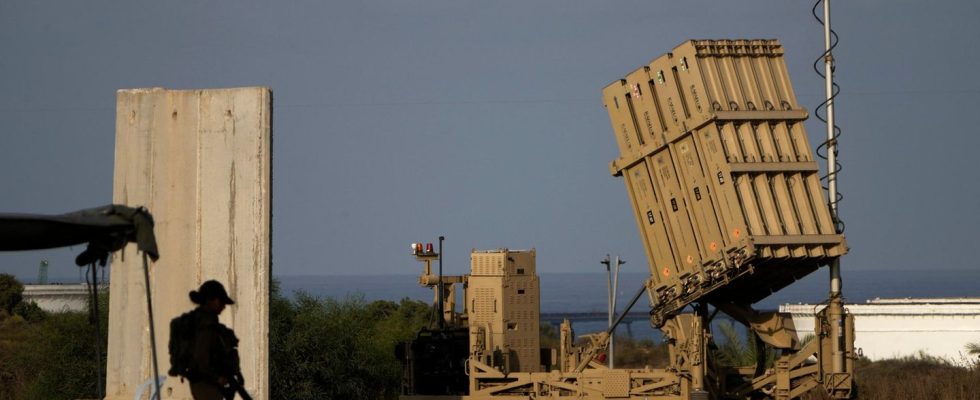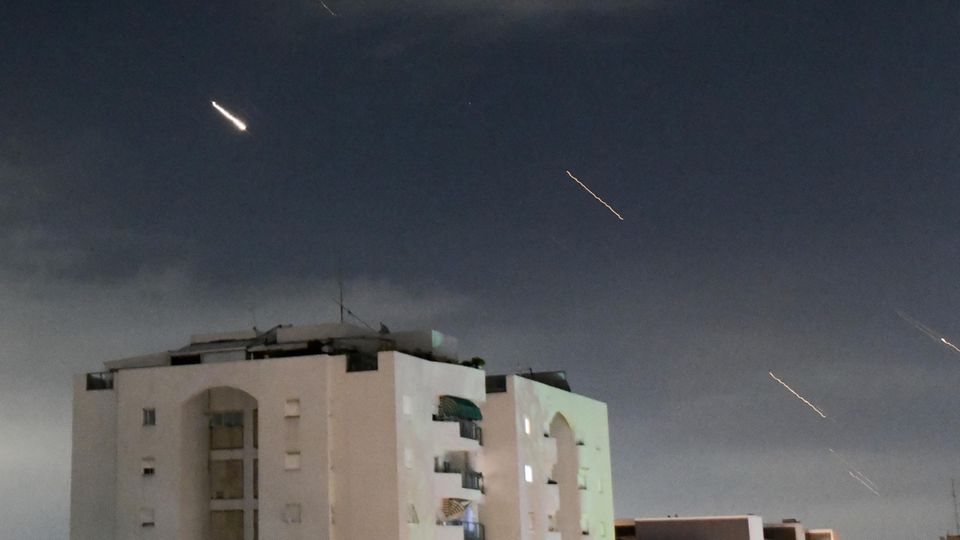Iran’s missile strike
Iron Dome, Arrow and David’s Sling – this is how the layers of Israeli air defense work
Israel repelled the Iranian attack with a sophisticated air defense system. The starter of the Iron Dome system is shown
© Ariel Schali / AP
Iran has fired over 300 missiles at Israel. Almost all of them were intercepted. But Israel had to reveal its defense strategy.
Iron Dome – for many this term is synonymous with air defense Israel. The dome is only part of a multilayer defense. The Iron Dome was designed specifically to counter Hamas rockets. These are simple, cheap rockets that are used in large numbers and at very short distances. The challenge is that the Iron Dome has to react very quickly to the targets – that’s why it works fully automatically. And that it must be able to shoot a large number of targets, so it itself requires large quantities of (affordable) defensive weapons.
The disadvantage is the limited range of the system. The Iron Dome only protects a zone about seven kilometers in diameter. In a sense, it is the last line of defense for attacks from Iran. Drones, rockets or cruise missiles from Iran should be stopped well in advance. If the Iron Dome is used against them, something has already gone wrong.
Test of Israel’s Defense
Iran’s attack is probably more of a test of Israel’s air defenses than a strike intended to cause damage. He began by launching a wave of simple drones that move at about 250 kilometers per hour. Filmed, publicly commented on and observed by US satellites. The Israelis and their US and British allies, plus the Jordanian Air Force, have attempted to intercept these drones over Iraq, Syria and Jordan. According to reports, it was possible to eliminate large parts of the drone fleet far from Israel’s borders, with the help of the Air Force and US installations in Iraq. So without intervention by rocket-based air defense in Israel.
Israel’s military said it worked with allies to intercept the “vast majority” of drones and missiles fired by Iran, most of them before they entered Israeli airspace. Later information mentions 331 missiles, of which 324 were intercepted.
Iran, in turn, spoke of a “success”. Army chief Mohammed Bagheri said on Iranian television on Sunday: “Operation ‘Honest Promise’ was carried out successfully between last night and this morning and achieved all of its objectives.” According to the Iranian army chief, no civilian targets or cities were targeted by the Iranian missiles. There were two main targets: the intelligence center that provided the information for the attack on the Iranian consulate building in Damascus, Syria, and the Nevatim military base from which the F35 fighter jets that bombed it took off. “These two centers have suffered significant damage and have been put out of commission.” Israel had assured that the Nevatim base had been slightly hit but was still functioning.
But how does Israeli air defense basically work? The system is divided into several parts:
Arrow
This system, developed jointly with the USA, is intended to intercept long-range missiles, including ballistic missiles, which Iran said it fired on Saturday. The Arrow system is newer and more powerful than the Patriot. The defense missiles measure around seven meters long. Depending on the type, the effective range is 90 kilometers or 150 kilometers. A special feature is their high speed, they reach nine times the speed of sound.
David’s Sling
This system only came into service in 2017. David’s Sling can be used against high-flying targets such as ballistic missiles as well as very low-attack cruise missiles. However, the range should only be around 25 kilometers
patriot
This US-made system is the oldest member of Israel’s missile defense system – it was used during the First Gulf War in 1991.
Iron Dome
The Iron Dome is specially tailored to the special threat situation in Israel. It protects the short distance. The effective range covers a zone of just seven kilometers radius, which is around 150 square kilometers.
The Iron Dome was designed from the start to ward off swarm attacks. A battery consists of a radar (EL/M-2084 multi-mode radar), a control center and up to four launchers with 20 missiles each. A unit can capture over 1000 objects and engage six attacking objects simultaneously. Because of the short time window, the processes are largely fully automatic. The system records a takeoff, calculates the flight path and impact location and recommends an operation – which can then be released. Despite its short range, the Iron Dome remains the heart of Israel’s security. He is the last line of defense. If long-range weapons miss their target, there is still the dome.
Determined reconnaissance attack
In terms of military results, the Israeli defense triumphed on Sunday night and Iran failed. The few missiles that made it through fell at the Nevatim air base with little precision. Further damage and an injured child were caused by falling debris. The Israeli information is probably embellished somewhat. Video clips suggest slightly more hits. Major damage cannot be kept secret for long in Israel. In a few days you will get an overview of the real damage.
Whether the operation was a success or a failure is another matter. Tehran tested Israeli air defenses. With an attack that was so large that Israel had to go into “emergency mode”. It is impossible to judge what insights and conclusions Iran has drawn from Israel’s defensive operations. What is certain, however, is that even an attack with 300 missiles would only have the dimensions of a test shot for Iran. The potential of Iran’s long-range weapons lies primarily in their sheer quantity and secondly in their sophisticated technology. At its core, Tehran’s approach is simple: whoever has more missiles wins the conflict. Iran’s calculation will be that Israel has to go “all in” on defense. Tehran, on the other hand, did not reveal the exact blueprint for a larger attack during the test attack. In an emergency, the regime is likely to have additional options.
In the event of a serious attack, Israel would have to expect far more missiles. But even if Tehran were to succeed in saturating Israel’s defenses, a triumph for the mullahs’ regime would be unlikely. In the event of a large wave, far more rockets would hit their targets in Israel. But even if the interception rate drops dramatically, it would not be possible to eliminate the Israeli military.




